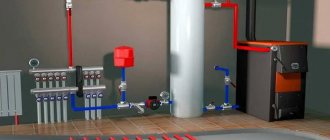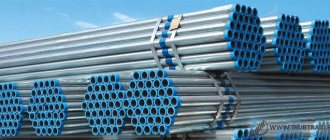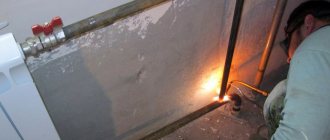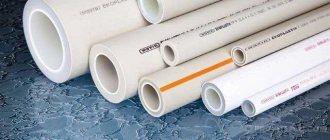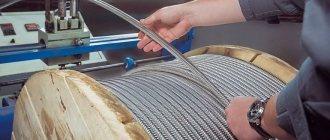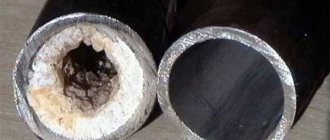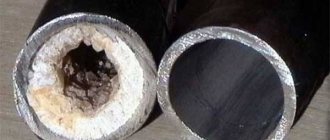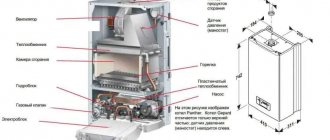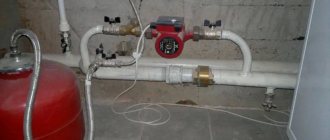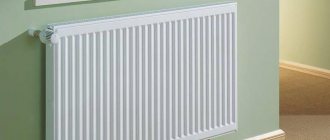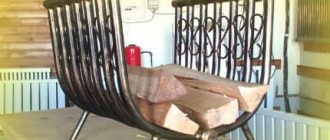With the development of technology, the attitude towards many construction works is radically changing. Installation of heating systems is no exception. Classic iron heating pipes are gradually giving way to more modern analogues. The most common replacement is polypropylene pipeline. Read on to learn how to select and install them.
Propylene pipes and fittings Source www.ket-kaluga.ru
General information about propylene pipeline
Quite a long time has passed since the use of polypropylene pipes for heating began for the experience of use to show that in the usual version they are not very suitable for these purposes. High temperature loads and pressure do their job, and the pipeline is subject to deformation.
As a result, propylene pipes, despite all their advantages, began to lose to classical metal in service life, although “de jure” manufacturers indicated completely different time frames for their products.
Engineers found a solution and began to use reinforcement when producing plastic pipes for heating. This made it possible to increase the service life of polypropylene pipes to 50 years, while maintaining all their advantages.
Price policy
Pipes made from polyvinyl chloride will cost more than their PVC counterparts. The cost depends on the characteristics, diameter, manufacturer. Taking these indicators into account, on average it is 1.5-5 US dollars per 1 meter, which is comparable to the price of galvanized steel pipes. However, if we take into account the low cost of installation, the best characteristics, including a long service life with minimal maintenance, the price/quality ratio will be in favor of CPVC pipes.
You should purchase products from well-established stores, or even better - from the manufacturers themselves or official dealers. When buying pipes, you need to ask the seller to provide a quality certificate and pay attention to the presence of a warranty period. These measures will help you avoid purchasing low-quality products produced by unscrupulous manufacturers.
Types of reinforcement
Several different reinforcement options are used, but according to the most popular solutions, most often a polypropylene heating pipe is reinforced with aluminum or fiberglass.
In the first option, the reinforcing material is aluminum foil. Its location may vary. Two technologies are used - with a surface arrangement and between the layers of the main body of the pipe. The foil gives the product the necessary rigidity and protects it from critical expansion.
Pipe with aluminum reinforcement Source thermohit.ru
The second option is considered more reliable, since propylene is reliably welded to fiberglass and does not allow the product to delaminate. Such pipes are stronger than those reinforced with foil.
In addition, when reinforced with aluminum, the complexity of welding increases, since in order to prevent delamination of the pipe body during its installation and further use, careful cleaning of the ends is required. Fiberglass does not have this disadvantage and such products are much easier to weld. They do not need any preparatory work.
When purchasing polypropylene for heating, it is advisable to give preference only to well-established manufacturers and intermediaries. This will allow you to purchase quality products and avoid counterfeit goods.
Despite the constant improvement of technological processes in the production of propylene pipes, it is not yet possible to completely prevent deformation during use. Therefore, a clear solution has not yet been found which polypropylene pipes are better for heating a private house. In most cases, they are guided by their experience and available funds.
Pipes with glass fiber reinforcement Source prom.st
How not to make a mistake
If you have chosen polypropylene pipes for yourself, go to the manufacturer’s official website before purchasing. You will need:
- Remember what the logo looks like, what font is used, what letters it contains, what color they are written in, how many capital letters. In general, you need to study the logo and its spelling. Those who make fakes deliberately make some mistake in the name, change/omit/double some letter. This is done so that claims cannot be made - the letter is different, the brand is different.
- Next, you need to study the assortment and choose what you want to purchase. Then carefully examine the color and location of the markings. If the store offers you a product of the desired campaign in a different color, size, etc., but this is not available on the official website, then they are selling you a fake. It's better to leave and look for another store.
All walls must be perfect - Please review product samples before purchasing. Pipes and fittings from normal companies have smooth walls (both external and internal). There should be no sagging, depressions or other signs of poor-quality casting.
- Look at the cut of the pipe or fitting. The wall thickness should be the same. If these are reinforced products, then the reinforcing material is surrounded by polypropylene rings of equal thickness. If the difference is noticeable even by eye, you should not buy such products.
Overall, you should have a positive impression of the quality of the products. Only if all the “tests” are passed, you can buy.
Characteristics
As for the technical indicators of propylene products, five main points can be distinguished:
- Pressure load resistance.
At this point, the most important factor is the temperature of the coolant. There is a direct relationship - with increasing temperature, the critical permissible pressure decreases. The vast majority of propylene pipes sold to consumers operate under a pressure of 4-6 MPa, while the circulating liquid can be heated no higher than 70 degrees. It is important to take these indicators into account when designing a heating system.
- Temperature stability.
Propylene, used in the production of products for heating systems, can withstand a short heating period of up to 95 degrees. Such indicators are not pumped into heating circuits. As for the softening threshold of propylene, it starts at 110-140 degrees. When the temperature increases to 140-170 degrees, propylene begins to melt. Considering these indicators, it becomes obvious that the use of products made from this material in heating systems is quite advisable.
Fittings and accessories for propylene pipes Source lammin.org
- Anti-corrosion properties.
In this quality it is difficult to argue with polypropylene. The material completely does not react to exposure to water. Since the surface of the pipe is smooth from the inside, this prevents the deposition of salt deposits, which are inevitable when the coolant is heated.
- Reduced thermal conductivity.
An important indicator that allows you to reduce heat loss from the coolant and prevent condensation from forming.
- Long operational period.
Most manufacturers guarantee the operation of their products for about 50 years. Compared to 20-30 years for iron pipes, this figure looks quite impressive. However, the time of use is influenced by many factors, ranging from pressure in the system circuits to temperature changes.
By and large, these pipes are worthy competitors to metal ones, and in some respects they are superior.
Manufacturers
Companies leading in the field:
- Rehau;
- Akwatherm;
- Pro Aqua (Russia);
- Wefatherm;
- RVC (Russia);
- Santrade (Russia);
- Politek (Russia);
- Ecoplastic (Czech Republic);
- FV-Plas;
- Wavin;
- T3S;
- Banninger (Germany);
- Heisskraft (Russia).
Note that the last four manufacturers in their assortment can find PP-RCT material (type 4, withstands higher pressure at the same temperature).
Chinese companies that you can also trust Dizayn and Blue Ocean.
Selection of pipes and propylene
Before purchasing propylene pipes, several factors are taken into account. First of all, you need to decide what pipe diameter is best to use for heating a private house. The cross-section directly depends on the pressure in the system circuits, and as it increases, the required diameter increases.
Fittings, taps and filters for propylene pipes Source lifetherm.com.tr
See also: Catalog of Russian-style house projects with a boiler room
Diameter
There are several main sizes of polypropylene heating pipes on the market:
- up to 16 millimeters - perfect for installing “warm floors”; adapters are used to circumvent the problem of low flexibility at small radii;
- from 20 to 25 millimeters - the most suitable solution for equipping a heating system in a house or apartment; pipes with a large cross-section are used for risers;
- from 25 to 32 millimeters - as a rule, used in heating systems of large houses;
- from 200 millimeters - such products are used to install heating systems for public facilities such as clinics, educational institutions, retail outlets and other facilities where there is often a significant flow of visitors.
Marking
When selecting polypropylene pipes for a heating system, the second significant factor that you need to focus on is labeling. Thanks to marking, it is possible to accurately determine the critical pressure and operating temperature of the product.
Markings on pipes Source is2.ecplaza.com
The most commonly used marking of polypropylene pipes used in heating communications fits into four points:
- "PN10". These products have relatively thin walls. For this reason, it is not advisable to include them in heating systems. Meanwhile, they are well suited for arranging “warm floors” and hot water supply. The pressure limit for them is 1 MPa. The nominal operating temperature is no more than 45 degrees.
- "PN16". This type of pipe can withstand higher pressure, up to 1.5 MPa. The maximum permissible temperature also increases - 60 degrees. The wall thickness of such pipes starts at 3.5 millimeters. All this suggests that they are applicable for organizing heating. Meanwhile, products with this marking are still quite sensitive to critical temperature jumps in the circuits, which can lead to their delamination, therefore, for a reliable heating system, it is necessary to use products with a different marking.
- "PN20". It is already permissible to include such products in heating systems. The main thing is to take into account the thickness of the walls; it should be around 16 millimeters. For PN20 pipes, the working pressure is 2 MPa, and the temperature is up to 80 degrees.
- "PN25". This mark indicates that the pipes operate under pressure up to 2.5 MPa. They are produced only in a reinforced version. Accordingly, it follows that for the installation of a heating system, they are the most suitable solution.
How to read markings on pipes Source build-experts.ru
Taking into account all the above characteristics, components for installing heating communications are also selected. It is worth emphasizing that the calculation and installation of heating communications for an apartment and a house have certain differences. Below we will consider in detail how heating based on propylene pipes is organized in various residential buildings.
See also: Catalog of companies that specialize in installation of utilities and autonomous gasification
What diameters should I connect?
We need to ensure the supply of the required thermal power, which will directly depend on the amount of coolant supplied, but the fluid speed must remain within the specified limits of 0.3 - 0.7 m/s
Then the following correspondence of connections arises (for polypropylene pipes the outer diameter is indicated):
- 16 mm - for connecting one or two radiators;
- 20 mm – for connecting one radiator or a small group of radiators (radiators of “regular” power within 1 - 2 kW, maximum connected power - up to 7 kW, number of radiators up to 5 pcs.);
- 25 mm – for connecting a group of radiators (usually up to 8 pieces, power up to 11 kW) of one wing (arm of a dead-end wiring diagram);
- 32 mm – for connecting one floor or an entire house, depending on the thermal power (usually up to 12 radiators, respectively, thermal power up to 19 kW);
- 40 mm - for the main line of one house, if any (20 radiators - up to 30 kW).
Let us consider the choice of pipe diameter in more detail, based on pre-calculated tabular correspondences of energy, speed and diameter.
Replacing old pipes
Taking into account the fact that we have quite a lot of housing built in the last century, the issue of replacing dilapidated communications is very relevant. Last but not least, this applies to heating systems. It is highly desirable that such work be carried out by qualified specialists. This will allow you to make correct calculations and perform installation correctly.
Even just when replacing old pipes, it is advisable to at least “with one eye” evaluate the heating scheme, because who knows how conscientiously the calculations were carried out two or three decades ago, especially taking into account the materials that were in use at that time.
Generally speaking, room heating can be organized using a one-pipe or two-pipe scheme. The type of heating system directly determines the complexity of installation work, cost, number of consumable components and quality of heating.
Propylene pipes and an old-style radiator Source aqua-gel.ru
In most cases, two-pipe circuits require the installation of more radiators. The optimal diameter of heating pipes in such systems is considered to be 32 millimeters. Of course, a single-pipe heating system is more economical in terms of costs. However, it must be taken into account that in such systems the liquid temperature, as a rule, decreases with each subsequent radiator. To level out this drawback, radiators have to be equipped with thermostats.
Modern radiators are much lighter and more elegant compared to their older cast iron counterparts; they also require the installation of a Mayevsky crane. It is necessary to bleed air during the start of the heating season. This requirement applies to both single-pipe and two-pipe heating systems.
In addition to the pipes themselves, many auxiliary accessories are used during installation:
- plugs;
- couplings;
- adapters;
- tees;
- fitting;
- clamps and others.
These and other necessary elements are selected in accordance with the type of communications and the diameter of the installed pipes.
Propylene pipes and a modern radiator Source www.daynews.com.ua
When deciding which pipes are best for heating, one should not forget that the welding speed depends on the diameter of the product. To connect propylene structures, a special apparatus is used, which craftsmen call an “iron”. To heat up and connect products with a diameter of about 25 millimeters, about 7 seconds are enough. Accordingly, pipes with a larger cross-section will require longer heating and installation.
It is advisable to consider the general procedure for installing a heating system for an apartment - as the most complete. It consists of the following steps:
- The first step is approval and obtaining permission for the upcoming work in the responsible utility organizations. This is required to quickly shut off the water supply. This may also be true for a private house if it is connected to central heating.
- When completely replacing the riser, it is necessary to coordinate these actions with the neighbors living above or below. Since not all people are eager to let strangers into their homes, completely replacing the riser will probably be impossible. In such cases, they resort to special adapters, through which it is possible to connect metal pipes and propylene.
- After all approvals, work is carried out to dismantle the outdated heating system. In this case, especially in older buildings, extreme caution will need to be taken. Over time, cast iron pipes begin to “crumble” at the slightest touch. This often leads to clogging of communications with fragments of the old pipe.
Warm floor made of polypropylene pipes Source otoplenieblog.ru
The main reasons for choosing polypropylene pipes for the heating circuit
The reasons, which, in fact, are the advantages of polypropylene pipes are as follows:
- Polypropylene has a distinctly low weight, which greatly simplifies its delivery to the work site and installation itself - no special devices or equipment are required.
- If you have the necessary tools, polypropylene pipes are easy to install, and welding techniques can be learned very quickly.
- The manufacturing material is absolutely harmless for residential premises, since it does not change its chemical composition even with strong heating and does not emit toxic fumes into the air.
- Thanks to the stabilizers included in polypropylene, pipes can withstand water hammer and thermal loads, and even freezing of water inside without rupture.
- The smooth inner walls of the pipes promote uniform, turbulence-free and noise-free circulation of the coolant.
- Both the pipes themselves and their components are inexpensive. A wide selection of components allows for installation of a circuit of any complexity.
A little training and any owner can carry out independent installation
- A circuit made of high-quality pipes, if installed correctly, will last at least 20–30 years.
- The aesthetic appearance of the pipes makes it possible not to spoil the interior, and the contour itself usually does not require either painting or additional decoration.
So, polypropylene pipes with a reinforcing aluminum layer are excellent for heating circuits of autonomous and central systems. In addition, the installation of this material is quite simple and feasible even for people who have no experience in such work. After several training sessions on the installation of individual components, the assembly process of the entire circuit can be carried out on your own.
Installation of a new system
As in the previous case, installing a heating system in a house begins with careful planning. We emphasize that for private sector housing the most preferable scheme is a two-pipe one. But initially it is determined what type of boiler it is planned to install. The boiler can be:
- gas;
- solid fuel;
- electric.
In areas with centralized gas communications, the first type of boiler is the most common. They are easy to maintain, but require increased safety precautions. The second type of boiler is installed, as a rule, in rural areas that do not have gas supply. In this case, this is the most economical option in terms of fuel. As for electric boilers, despite their ease of operation, energy costs can become quite significant.
Heating made of polypropylene in a private house Source santex-tomsk.ru
Final conclusions
There is no clear answer to the question of what is better to use for heating – polypropylene or metal-plastic. Much depends on the circumstances and capabilities of the homeowner. The following conclusions suggest themselves:
- By choosing propylene, you save a lot of money, but you must achieve high-quality installation by all means. With a large number of connections, invisible defects may still occur.
- You will have to pay decent money for metal-plastic - this is the main disadvantage. If we can overcome it, then otherwise you won’t have any problems.
Finally, an important note: remember that “crooked” craftsmen are able to ruin any material, even the most expensive and high-quality one. Pay special attention to the contractors you choose for the heating installation in your home. Otherwise, you will subsequently get leaks described in the video:
